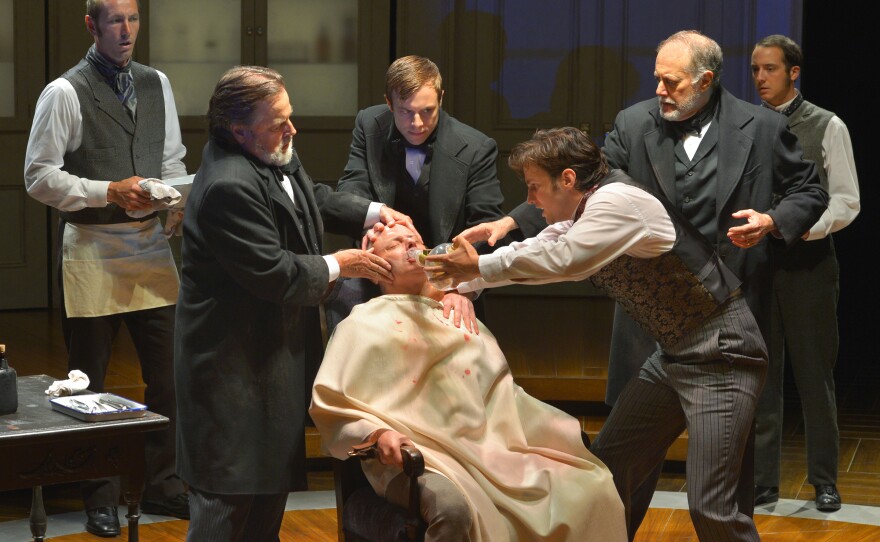You can't help but cringe during the opening scene of the La Jolla Playhouse's "Ether Dome."
It's 1846 and a dentist in Hartford, Connecticut named Horace Wells is pulling out a woman's tooth. She's had no anesthesia. Her arms and legs are strapped in. Wells is practically in her lap, trying to get the right leverage. There's blood.
Finally he falls back, having yanked the tooth from the final root.

In the mid-19th century, having surgery or dental work meant agonizing pain. A patient getting his leg amputated might only get whiskey and a leather strap to bite down on.
Wells was considered a good dentist because he was fast. "But he was sort of tortured because he inflicted so much pain in removing teeth," says Michael Bakkensen, the mustachioed actor playing Wells.
"The adage of the day was that a surgeon or a dentist would bring along two bottles of whiskey, one for the patient and one for themselves," explained Bakkensen.

Many of the dentists and surgeons of the day were haunted by the screams of their patients. And yet it took years to devise a solution to eradicate the pain of surgery.
"The play is about who invented the idea that by inhaling a gas, we can actually put people under and then perform surgery painlessly," explains Michael Wilson, the director of "Ether Dome."
The play is based on a true story.
Wells realized inhaling laughing gas — or nitrous oxide — through a balloon would help patients feel less pain. He taught everything he knew to his student, William Morton, who — unbeknownst to Wells — was an experienced conman with 14 different aliases.

"You think of 'The Talented Mr. Ripley,' with William, or 'Catch Me if You Can,'" said Wilson, referring to popular films featuring handsome protagonists who are not what they seem.
Morton took Wells' idea of inhaling gas, added ether instead of nitrous oxide based on a suggestion from a well-known Harvard surgeon, and anesthesia was born.
"William Morton had never been to school, much less medical school," said playwright Elizabeth Egloff. "He had no scientific background whatsoever. But he had the nerve to put the patient's life in danger."
"Without William's daring and perhaps reckless drive and ambition to achieve his compound, it could have been in research and development collecting dust for years," said Wilson.
The discovery gave birth to modern medicine. Suddenly hospitals needed more staff and beds to accommodate the number of patients. "Everybody wanted to have surgery because they could," said Wilson.

Morton took all the credit for the discovery and never acknowledged his teacher Horace Wells. This destroyed the sensitive dentist. He began experimenting with drugs, especially chloroform.
"The chloroform was the equivalent saying I guess I’ll try heroin on myself," explained actor Michael Bakkensen. "Within a year he was living in squalor conditions in New York and got himself into major, major trouble."
Wells was arrested for throwing sulfuric acid on prostitutes on the streets of New York. He went to jail and ended up committing suicide. Some believe Wells was the inspiration for the fictional short stories about Dr. Jekyll and Mr. Hyde.
Wells' spiral downward from a good man to a deranged one gives the play its humanity.
Meanwhile his famous student, William Morton, ever the opportunist, realized he could patent and sell inhalation anesthesia. But he never made his money. His dubious background was revealed. He died young and poor in Central Park.
The title "Ether Dome" refers to the surgical theater in Boston’s Massachusetts General Hospital where Morton first demonstrated how anesthesia worked.
To this day, Mass General gives William Morton the credit for discovering inhaling anesthesia.
There is no mention of the dentist Horace Wells.
"Ether Dome" runs through August 10th at the La Jolla Playhouse.







